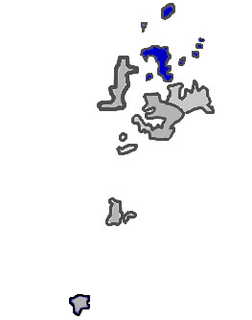
The National Sun Yat-sen Memorial Hall is located in Xinyi District, Taipei, Taiwan. It is a memorial to the Republic of China's National Father, Dr. Sun Yat-sen, and was completed in 1972. The total building area covers 29,464 square metres in an open space of 115,000 square metres. It contains displays of Sun's life and the revolution he led, and is also a multi-purpose social, educational and cultural center for the public.

Cihu Mausoleum, officially known as the Mausoleum of Late President Chiang or President Chiang Kai-shek Mausoleum is the temporary resting place of President Chiang Kai-shek. It is located in Daxi District, Taoyuan City, Taiwan. When Chiang Kai-shek died in 1975, he was not buried in the traditional Chinese fashion but entombed in a black marble sarcophagus since he expressed the wish to be eventually buried in his native Fenghua in Zhejiang province once the Kuomintang (KMT) recovered mainland China from the Communists.

Ketagalan Boulevard is an arterial road in Zhongzheng District in Taipei, Taiwan, between the Presidential Building and the East Gate (東門). It is 400 metres (1,300 ft) long and has a total of ten lanes in each direction with no median.

The Grass Mountain Chateau is a former residence of late President of the Republic of China Chiang Kai-shek located in Beitou District, Taipei, Taiwan in Yangmingshan National Park.

Baisha Township is a rural township in Penghu County, Taiwan. It is located at the northern part of Penghu Main Island and linked to Siyu Township by the trans-oceanic bridge, which at 2.5 km (1.6 mi) long makes it the longest of its kind in east Asia. It has a population of 9,809.

Chengcing Lake (Chinese: 澄清湖; Hanyu Pinyin: Chéngqīng Hú; Tongyong Pinyin: Chéngcing Hú; Wade–Giles: Ch'eng2-ch'ing1 Hu2), also known as the Cheng Ching Lake, Dabei Lake (大貝湖), or Toapi Lake (Chinese: 大埤湖; Pe̍h-ōe-jī: Tōa-pi-ô͘) in Taiwanese, is an artificial lake located in Niaosong, Kaohsiung, Taiwan. The lake is not far from downtown Kaohsiung and the major suburban district of Fengshan. The lake is a source of the water supply network and a tourist area of the Kaohsiung region.

The National Penghu University of Science and Technology is a public university located in Magong City, Penghu, Taiwan. It is one of the few higher education institutions located outside of Taiwan Island.

The Shilin Official Residence is the former residence of late Republic of China President Chiang Kai-shek located on Zhongshan North Road in Shilin District, Taipei, Taiwan.
The Zhongxing Guesthouse also known as the Yangmingshuwu is a historical site located in on Zhongxing road in Yangmingshan National Park in the Beitou District of Taipei, Taiwan. It was constructed between 1969 and 1970 by late Republic of China President Chiang Kai-shek for reception of important foreign guests and to act as a summer residence. It was designed by architect Huang Baoyu (黃寶瑜), who also designed the National Palace Museum.
The Penghu Living Museum is a museum about the customs and culture of Penghu in Magong City, Penghu County, Taiwan.

The Penghu County Council is the elected county council of Penghu County, Republic of China. The council composes of 19 councilors lastly elected through the 2014 Republic of China local election on 29 November 2014.

Central Street is a street in Magong City, Penghu County, Taiwan. It is the oldest street in the city.

The Penghu Aquarium is an oceanarium in Baisha Township, Penghu County, Taiwan.

The Xiyu Eastern Fort or Xiyu Eastern Battery is a former fort and battery in Wai'an Village, Xiyu Township, Penghu, Taiwan.

The Penghu Reclamation Hall is a former residence in Magong Township, Penghu County, Taiwan.

Magong Chenghuang Temple is a temple in Magong, Penghu, Taiwan. This temple mainly serves Chenghuangye, means the lord of City., a taoist God, who is in charge of the underworld of an administrative district, so it was translated to the City God usually.

Penghu Shuixian Temple(Chinese: 澎湖水仙宮; pinyin: Pēnghú shuǐxiān gōng), is a Taoist temple in Magong, Penghu. Built on 1696 by Xue Kui (薛奎), a military officer of Penghu Navy, it mainly serves the Shuixian Zuwang, five Taoist immortals worshipped as sea gods.
Pan An-bang, was a Taiwanese pop and folk singer, television presenter and actor. He was famous for the song “Grandma’s Penghu Bay" (外婆的澎湖灣), which is one of the classic Taiwanese campus folk songs in the late 1970s. He was also one of the first pop singers from Taiwan to perform in mainland China in the 1980s. After the successful nationwide television performance on CCTV New Year's Gala in 1989, he became well-known on both sides of the Strait. He died from kidney cancer in 2013.

Longgui Park is a park in Guangfu Village, Magong City, Penghu County, Taiwan. It is a small community park of 380 hectares and was founded on July 20, 2001 by Lai Feng-wei, the magistrate of Penghu.




















